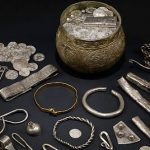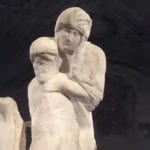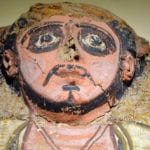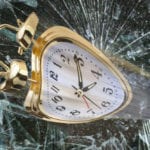 Miscellaneous
Miscellaneous  Miscellaneous
Miscellaneous  Politics
Politics 10 Lesser-Known Far-Right Groups of the 21st Century
 History
History Ten Revealing Facts about Daily Domestic Life in the Old West
 Weird Stuff
Weird Stuff 10 Everyday Products Surprisingly Made by Inmates
 Movies and TV
Movies and TV 10 Actors Dragged out of Retirement for One Key Role
 Creepy
Creepy 10 Lesser-Known Shapeshifter Legends from Around the World
 Animals
Animals 10 Amazing Animal Tales from the Ancient World
 Gaming
Gaming 10 Game Characters Everyone Hated Playing
 Books
Books 10 Famous Writers Who Were Hypocritical
 Humans
Humans 10 of the World’s Toughest Puzzles Solved in Record Time
 Miscellaneous
Miscellaneous 10 Ironic News Stories Straight out of an Alanis Morissette Song
 Politics
Politics 10 Lesser-Known Far-Right Groups of the 21st Century
 History
History Ten Revealing Facts about Daily Domestic Life in the Old West
Who's Behind Listverse?

Jamie Frater
Head Editor
Jamie founded Listverse due to an insatiable desire to share fascinating, obscure, and bizarre facts. He has been a guest speaker on numerous national radio and television stations and is a five time published author.
More About Us Weird Stuff
Weird Stuff 10 Everyday Products Surprisingly Made by Inmates
 Movies and TV
Movies and TV 10 Actors Dragged out of Retirement for One Key Role
 Creepy
Creepy 10 Lesser-Known Shapeshifter Legends from Around the World
 Animals
Animals 10 Amazing Animal Tales from the Ancient World
 Gaming
Gaming 10 Game Characters Everyone Hated Playing
 Books
Books 10 Famous Writers Who Were Hypocritical
 Humans
Humans 10 of the World’s Toughest Puzzles Solved in Record Time
10 Amazing Treasures of the Anglo-Saxons
From the 4th century, Europe underwent a series of mass migrations of peoples as the power of Rome diminished. A series of Germanic tribes began to enter Britain after the withdrawal of Roman forces in AD 410. For the next 600 years, a distinctive Anglo-Saxon culture developed in England, but it is a relatively little-known period. Unlike the Romans, who left a wealth of written documents and stone buildings, most of the structures of the Anglo-Saxons were made of wood and have vanished.
Because we have so few sources for this period, historians once called the time of the Anglo-Saxons the Dark Ages. A close study of the artifacts that survive from this time reveals just how impressive this period was.
Here are ten treasures of the Anglo-Saxons that have been recovered.
Related: Top 10 Rumored Locations Of Long Lost Treasure
10 Sutton Hoo Helmet
The Sutton Hoo excavations caused a sensation in England in 1939. A great mound of earth was dug into to see if the remains of a burial could be discovered. Other similar mounds had been raided long ago by treasure seekers, so there was not much hope that anything extraordinary would be found. But the archaeologists soon uncovered a spectacular ship burial packed with Anglo-Saxon finds.
Alongside huge gold and silver brooches and other grave goods, there were hundreds of rusty fragments that appeared to be important. It was only with a great deal of work that the pieces were joined together to reveal the remains of a rare Anglo-Saxon helmet – and one so brilliantly made that many researchers think it belonged to King Raedwald of East Anglia.
The helmet has many of the motifs associated with Anglo-Saxon art. The crest of the helmet is a golden dragon with panels that make it look as if its wings are extended. Plaques of metalwork were beaten to form images of humans, warriors on horseback, and deities. Most important is the face plate, which would have covered the wearer’s own face. By looking at this mask, we see the Anglo-Saxons as they wished to portray themselves.[1]
9 Staffordshire Hoard
It is the dream of everyone who goes out metal detecting to pick up a signal, dig a hole, and turn up a hoard of treasure. In 2009, Terry Herbert did just that in a Staffordshire field. Within days, over 200 fragments of gold had been pulled up. When archaeologists were called in, a full excavation revealed a total of 1,500 items of valuable Anglo-Saxon art.
The totality of the hoard contained over 11 pounds (5 kilograms) of gold, 3 pounds (1.4 kilograms) of silver, and thousands of carved garnets. The value of the hoard is not in the precious metals, however, but in what it tells us about the Anglo-Saxon world. Most of the hoard came from military items like sword pommels, helmet parts, and armor fittings. Some pieces contain images of the Anglo-Saxons that connect us directly to the past.
The gold work is packed with details formed from minuscule work done with fine wires that each had to be delicately soldered on. The garnets that stud many of the pieces must have been imported to Britain from as far away as India or Central Europe. Anglo-Saxon Britain was not cut off from the rest of the world after all.[2]
8 Anglo-Saxon Glass
Roman glasswork is pretty striking stuff. Across the empire, examples have been found with a huge range of colors and complex forms. Once the Romans left Britain, however, the amount of glass in the country diminished greatly under the Anglo-Saxons. This is for a good reason—many of the key ingredients to make glass were found in Egypt and exported by the Romans. This does not mean the Anglo-Saxons had no glass, though.
Anglo-Saxon graves often contain glass beads that were left with the dead. These are often in vivid colors and marked with complex patterns and shapes. Usually, they are found with female skeletons and seem to have been worn on strings. Beads obviously require less glass than other glass objects, but they are still beautiful.
The Anglo-Saxons did have some impressive glasswork. Beakers and drinking horns made from glass have been found left as grave goods, which shows that over time, the Anglo-Saxon glass-blowers produced highly detailed works and improved the quality of the little glass they had as time progressed. [3]
7 Lindisfarne Gospels
Books from Anglo-Saxon England are incredibly rare. Of the 1,000 known to have survived, none is more important than the Lindisfarne Gospels. The small island of Lindisfarne on the northeast coast of England was one of the key sites of Christianity at the time and a beacon of learning. In the early 8th century, a monk called Eadfrith began copying a Latin version of the four gospels. As a vital religious work, he decided to make his book a masterpiece of art, too.
The Lindisfarne gospels are a riot of decoration using all the reds, blues, greens, and yellows that were employed in the illumination of manuscripts. Gold flecks glimmer from many pages. The decoration is so richly detailed that a single page can include over 10,000 individual red dots. The artistic style employed draws from Roman, Celtic, and Anglo-Saxon motifs. Books such as this were a tool used in the conversion of Britain to Christianity as they were impressive works that would symbolize the power of the new God.
In the 10th century, a priest named Aldred wrote a translation of the text into Old English between the lines of the Latin original. This is the earliest translation of the Bible into English that we know of.[4]
6 Brooches
Brooches were an important part of getting dressed for the Anglo-Saxons. They did not have zippers or other ways of easily joining their clothes together. Poorer people might use simple pins made from bone or metal, but those with money, particularly women, went for showier brooches made from gold, silver, and decorative stones.
The front of a brooch covers the pin and hinge at the back and is where artistry, fashion, and power could be displayed. Some of the brooches that have been discovered seem overly large to us, but how better to show off your fortune than by literally wearing it? The Kinston brooch, nearly 3 inches (7.6 centimeters) in diameter, is covered in filigree gold work, intricately shaped garnets, blue enamel, and pearls.
The owners of such brooches knew their value. One we know was owned by a woman called Ædwen because she left an inscription that calls on God to curse anyone who takes it from her without her explicit agreement.[5]
5 Gold and Garnets
Garnets today are not the most fashionable gemstones. They are relatively cheap and common. They come in a variety of colors, but their translucent red has always been the most highly prized. For the Anglo-Saxons, however, garnets were the premier gem they used to decorate all their metalwork. From swords to helmets to brooches, garnets were employed to show their owner’s wealth and importance.
Anglo-Saxons did not facet their gems as we do but instead sliced them thinly and then carved them into shapes that could be slotted closely together to form patterns. Each of the stones was separated by a small wall of gold. Getting the size and shape of the tiny garnets exactly right was key to making a piece of jewelry, and it was all done by eye.
To make the garnets even more impressive, they were often backed with gold foil so that they would reflect sunlight back out through the stone. This would have made them glimmer and glow in sunlight. This foil was sometimes patterned to further increase their beauty.[6]
4 Anglo-Saxon Sword
The Anglo-Saxon world was one of frequent warfare between rival kings vying for power. Many of the hoards of treasure from the Anglo-Saxons are believed to have been items taken from the dead after battles, buried, and then never retrieved. Given the importance of weapons to Anglo-Saxon warriors, it is not surprising that they were often created with the aim of proclaiming their owner’s status.
The pommels of the swords were often covered in gold, silver, and the ubiquitous Anglo-Saxon garnets. Hoards of treasure often contain many of these valuable pommels that were hacked off swords after losses in battles.
The sword blades themselves were also feats of metalwork. Anglo-Saxon smiths were not able to create ingots of iron as we would know them. Their furnaces produced small nuggets of iron that would have to be forge-welded together to create a long enough blade. This required a huge amount of skill if the sword was not to shatter the first time it was used.[7]
3 Bayeux Tapestry
The Anglo-Saxon period of English history came to an end in 1066 when William the Conqueror from Normandy invaded and took the throne. It is perhaps ironic that one of the last pieces of Anglo-Saxon high art was created to celebrate the end of the Anglo-Saxon age. The Bayeux Tapestry, actually an embroidery, tells the story of the Norman conquest through images and words over 230 feet (70 meters) of fabric.
It is thought that the Bayeux Tapestry was commissioned by King William’s half-brother, Bishop Odo, just a few years after the fateful Battle of Hastings, and it was made in England by Anglo-Saxon needleworkers. The dyes, style of stitches, and textual evidence all point to Anglo-Saxon influences.
The tapestry shows all the key moments of the conquest, from the death of King Edward the Confessor to William setting sail from France to the fall of King Harold. The image of what is thought to be King Harold with an arrow in his eye gave rise to the popular notion that this is how he died. The tapestry also contains the first image of Halley’s Comet.[2]
2 The Franks Casket
Carved bone and ivory tend not to survive as well as objects made from metal. Unless cared for or buried under the right conditions, it will often fall apart. That makes the survival of the Franks Casket—now in the British Museum—all the more remarkable. Originally made from whalebone in the 8th century in northern England, it helps to give some idea of just how decorated the Anglo-Saxon world was.
It seems to have been made in a monastery but shows folkloric and mythic scenes from Anglo-Saxon tales, the birth of Romulus and Remus, and various animals. Each is carved from the bone in exquisite detail. Around the edge of the bones are various inscriptions ranging from Old English written in runes to Latin.
The casket had a checkered history. At some point, the casket was taken to a church in France. It seems to have been looted during the French Revolution and used as a sewing box. The silver fittings which held the box together were stripped off and exchanged for a silver ring. Most of the panels of the box ended up in the British Museum, but some were only later discovered at the bottom of a drawer and are now in a French museum.[9]
1 Alfred Jewel
Only one king in English history was given the title “the Great.” Alfred the Great was king of the West Saxons from AD 871–886 when he began to style himself as king of the Anglo-Saxons. His reign was marked by conflict with the Vikings, but his was not a wholly military career. He was also renowned for his patronage of scholars and support for learning. In 1693, a jewel was discovered, which added to this reputation as a learned monarch.
The Alfred Jewel is made of gold, rock crystal, and enamel. Beneath the highly polished crystal at the center of the piece is the image of a man with holy symbols. It is not clear who this figure is meant to represent, but the jewel leaves no doubt about who had it made. Around the edge in Old English is the message “Alfred had me made.”
Intriguingly, we might know what this jewel was used for. At the bottom of the jewel is a circular socket where something was once inserted. This probably held a stick of wood, and the jewel was used as a pointer, or aestal, to help someone indicate words on a page while they read. We know Alfred had fifty such pointers made when he sent out copies of a book from the pope to each bishop in the country, as he wrote about them in the introduction to the book. Alongside was an instruction that the pointer was not to be separated from the book. Since we have the Alfred Jewel and not the book it was attached to, it seems someone did not listen to that bit.[10]








